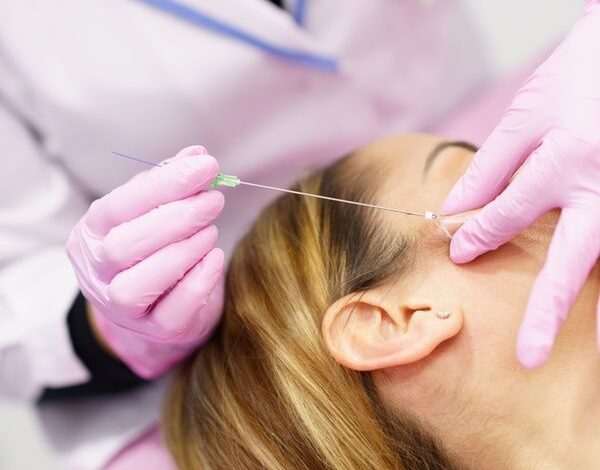
Are you tired of wrinkles, sagging skin, and the inevitable signs of aging? Say goodbye to invasive procedures and hello to PDO threads – the revolutionary non-surgical facelift that’s taking the beauty world by storm!
If you’re curious about this groundbreaking innovation and how it can help turn back the clock on your appearance, you’ve come to the right place.
In this blog post, we’ll take a deep dive into understanding PDO threads – their benefits, procedure details, and everything else you need to know for a youthful transformation without going under the knife. Get ready to discover the latest secret weapon in anti-aging treatments – let’s thread our way toward timeless beauty together!
Introduction to PDO Threads
PDO threads are the latest innovation in non-surgical face lifts. They are made of polydioxanone, a material that is commonly used in surgical sutures. It is inserted into the skin using a needle and can be left in place for up to six months.
The threads cause collagen production and provide support to lift sagging skin. The threads are absorbable and will not leave any permanent scars. These have been used safely in Europe and Asia for many years and are now available in the United States.
A facelift with PDO can take as little as 30 minutes and does not require any anesthesia or recovery time. There may be some bruising and swelling after the procedure, but this usually resolves within a week. Results can last up to two years.
Benefits of PDO Threads
PDO threads have quickly become one of the most popular non-surgical facial rejuvenation treatments due to their wide range of benefits. PDO threads can provide an immediate lift to drooping skin, help smooth out fine lines and wrinkles, and improve the overall texture and tone of the skin. In addition, PDO threads stimulate collagen production, which leads to long-term improvements in the appearance of the skin.
One of the biggest benefits of PDO threads is that they are a completely minimally-invasive procedure. There is no cutting or incisions required, and the treatment can be done in under an hour. There is also very little downtime associated with PDO threads, so patients can typically return to their regular activities immediately after treatment.
Another great benefit of PDO threads is that they provide long-lasting results. Unlike other types of facial rejuvenation treatments such as Botox or fillers, which only last for a few months, PDO threads can provide results that last up to 2 years. This makes them a great option for those looking for a more permanent solution to their aging concerns.
If you are considering PDO threads for your own facial rejuvenation needs, be sure to consult with an experienced aesthetician or plastic surgeon who can assess your individual needs and recommend the best course of treatment.
Types of PDO Threads
PDO threads are made of polydioxanone, a material that is commonly used in surgical sutures. The threads are inserted into the skin using a needle and cause the skin to tighten and lift over time. There are three types of PDO threads: smooth, barbed, and cog.
Smooth threads are the simplest type of thread and are typically used for small areas such as the crow’s feet or forehead. Barbed PDO threads have tiny hooks on them that help to anchor the thread in place and provide a more significant lifting effect. Cog PDO threads have raised bumps along their length that help to grip the tissue and create a more volumizing effect.
It can be left in place for up to 6 months before they need to be removed or replaced. The results of PDO thread lifts typically last for about 1-2 years.
How Does the Procedure Work?
Threads are a type of surgical suture made from polydioxanone, a synthetic absorbable material. They are often used in orthopedic surgery to support soft tissue and bone healing. In cosmetic surgery, PDO are used for various purposes, including facial rejuvenation and body contouring.
Thread lifts involve the insertion of thin PDO threads into the skin using a needle. The threads are placed in specific areas in order to lift and support sagging skin or tissue. Once the threads are in place, they will dissolve over time. However, the collagen that is produced in response to the threads will provide long-lasting support and results.
Thread lifts can be used to treat a variety of concerns, including wrinkles, hooded eyes, drooping brows, sagging cheeks, and jowls. They can also be used to improve the appearance of scars or stretch marks. PDO thread lifts are a minimally-invasive alternative to traditional facelift surgery.
Recovery Process and Aftercare
PDO threads are a new, minimally-invasive way to achieve a facelift without surgery. The threads are inserted into the skin using a needle and then pulled tight to lift the skin. The threads dissolve over time, but the lifting effect is said to last for up to two years.
The recovery process is relatively simple and quick. You will likely have some bruising and swelling after the procedure, but this should resolve within a few days. You may also have some temporary numbness or tingling in the treated area. It is important to avoid strenuous activity or exposure to sunlight for at least 24 hours after the procedure.
Aftercare is also fairly simple. You will need to clean the treated area twice daily with a mild soap and water solution. Avoid using harsh cleaners or scrubbing too vigorously, as this can irritate the skin. You should also apply sunscreen when outdoors, as your skin will be more sensitive after the procedure.
Possible Side Effects
It is important to understand that PDO threads are a medical procedure and, as with any medical procedure, there are potential risks and side effects associated with them. These include but are not limited to bruising, swelling, pain, numbness, redness, infection, and formation of scar tissue.
It is rare, but some patients may also experience thread breakage or migration. It is important to consult with a board-certified plastic surgeon prior to having PDO threads placed to ensure that you are a good candidate for the procedure and to discuss all potential risks and side effects.
Alternatives to PDO Threads
If you’re looking for alternatives to PDO threads, there are a few options available. One option is dermal fillers. Dermal fillers can help to plump up the skin and smooth out wrinkles. Another option is laser skin resurfacing. Laser skin resurfacing can help to improve the appearance of the skin by reducing wrinkles and fine lines.
Conclusion
PDO threads offer a safe and effective non-surgical solution to facial rejuvenation. Having an understanding of how they work, their benefits, and the potential risks associated with them is essential for anyone considering undergoing this procedure.
With proper research and consultation with experienced healthcare practitioners, it can be possible to achieve beautiful results without having to go under the knife. So do your research; talk to your doctor; and explore the possibilities that PDO threading has to offer – you may find yourself pleasantly surprised at just what you discover!




